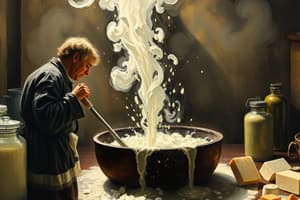Podcast
Questions and Answers
What is the primary reason early soaps were not used for personal hygiene?
What is the primary reason early soaps were not used for personal hygiene?
- They formed insoluble complexes in the presence of calcium and magnesium ions
- They were derived from natural sources of fats and oils
- They possessed unbearable odors
- They contained excessive amounts of unreacted caustics (correct)
How are modern soaps produced?
How are modern soaps produced?
- Continuous saponification only
- Hydrolysis/neutralization only
- Kettle boiling only
- Using a variety of processes including kettle boiling, continuous saponification, and hydrolysis/neutralization (correct)
What distinguishes soaps from other synthetic surfactants?
What distinguishes soaps from other synthetic surfactants?
- They form insoluble complexes in the presence of calcium and magnesium ions
- They are derived directly from natural sources of fats and oils (correct)
- They possess unbearable odors
- They require additional chemical manipulations such as sulfonation and esterification
What is a common property of soaps in the presence of calcium and magnesium ions?
What is a common property of soaps in the presence of calcium and magnesium ions?
Why does hard water reduce the effectiveness of soap as a surfactant?
Why does hard water reduce the effectiveness of soap as a surfactant?
What effect has the insensitivity of synthetic surfactants to water hardness had on the use of soap?
What effect has the insensitivity of synthetic surfactants to water hardness had on the use of soap?
Why are soap-based personal cleansing products being rapidly replaced by products containing increasing amounts of synthetic surfactants?
Why are soap-based personal cleansing products being rapidly replaced by products containing increasing amounts of synthetic surfactants?
Hard water has high levels of both calcium and ______
Hard water has high levels of both calcium and ______
Many synthetic surfactants are considerably less susceptible to water ______
Many synthetic surfactants are considerably less susceptible to water ______
Soap-based personal cleansing products are being rapidly replaced by products that contain increasing amounts of synthetic surfactants to meet changing consumer needs, such as rinsing and lather in ______ water
Soap-based personal cleansing products are being rapidly replaced by products that contain increasing amounts of synthetic surfactants to meet changing consumer needs, such as rinsing and lather in ______ water
Soap is one of the oldest known manufactured chemical substances and was first produced thousands of years ago through the reaction of animal fats with the ashes from ______.
Soap is one of the oldest known manufactured chemical substances and was first produced thousands of years ago through the reaction of animal fats with the ashes from ______.
Early soaps were used primarily for the cleansing of clothing, not for personal hygiene, because of cultural as well as practical ______.
Early soaps were used primarily for the cleansing of clothing, not for personal hygiene, because of cultural as well as practical ______.
Today soaps are produced using a variety of processes, including kettle boiling, continuous saponification, and hydrolysis/ ______, as well as different fats and oils feedstocks.
Today soaps are produced using a variety of processes, including kettle boiling, continuous saponification, and hydrolysis/ ______, as well as different fats and oils feedstocks.
Fats and oils are triglycerides, i.e., molecules comprising a glycerol backbone and three ester-linked ______.
Fats and oils are triglycerides, i.e., molecules comprising a glycerol backbone and three ester-linked ______.
Flashcards are hidden until you start studying




